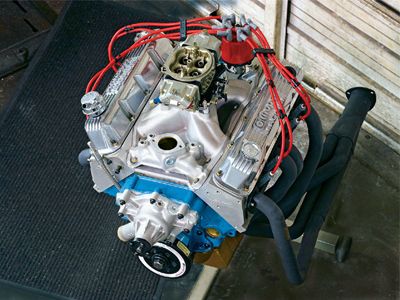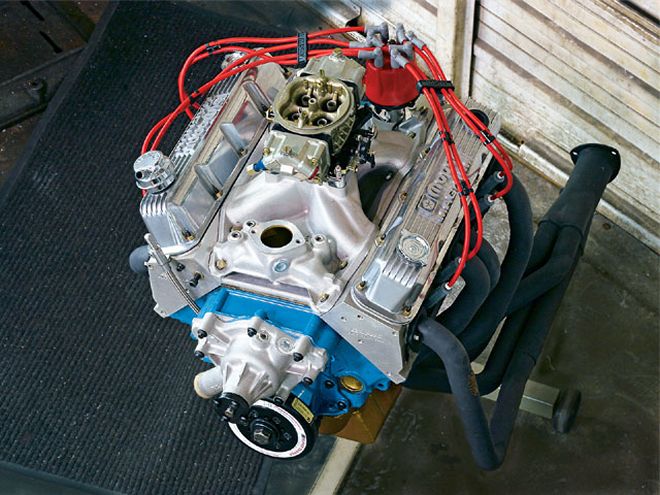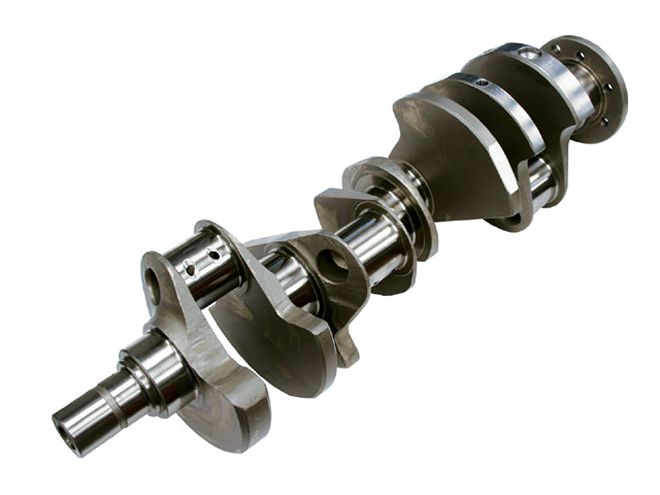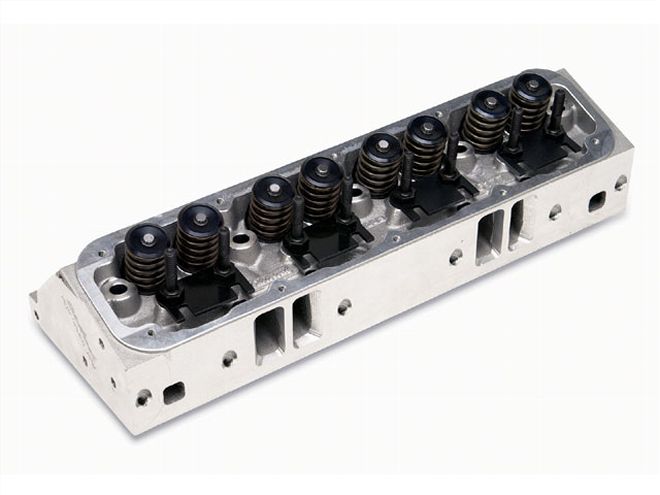
 Peaking at 501 hp, the 414's power output is respectable, but more impressive is its average torque of 500 lb-ft from 4,000 to 5,000 rpm.
Peaking at 501 hp, the 414's power output is respectable, but more impressive is its average torque of 500 lb-ft from 4,000 to 5,000 rpm.
Hemis and 440s may get all the chicks, but the most dedicated troops in Chrysler's infantry through the decades have been the LA-series small-blocks. Their many derivatives have powered everything from musclecars to late-model pickups and SUVs. As such, while they might not be what most Mopar guys dream of building, they are what many of them choose to build as practicality and real-world budgets take precedence over visceral lust. That scenario certainly applies to Robert Thornburgh of Brandon, Mississippi, who envisioned a potent yet streetable pump-gas 340 for his '73 Duster.
He told us all about it on his entry form for the HOT ROD High Performance Engine Makeover contest sponsored by 104+ Octane Boost way back in the July '04 issue. That the motor was going into something other than a Camaro or Nova scored bonus points with our panel of judges, as did his plan to attach a four-speed stick behind it. Those factors helped him to win the grand prize, which includes a $10,000 engine makeover, a year's supply of 104+ Octane Boost, and a HOT ROD leather jacket. The School of Automotive Machinists (SAM) in Houston, Texas, stepped up to build the motor and will provide installation services in the near future. We followed along during the build to show how to stroke a 340 without totally destroying your bank account. Stay tuned for a full drag test once the car's all buttoned up.
 The Eagle steel crank was internally balanced to 0.25 ounce-inches with a total bobweight of 1,905 grams. The 340 features modest-sized 2.500-inch main journals that keep bearing speed and friction in check.
The Eagle steel crank was internally balanced to 0.25 ounce-inches with a total bobweight of 1,905 grams. The 340 features modest-sized 2.500-inch main journals that keep bearing speed and friction in check.
Short-Block
The recent influx of dirt-cheap aftermarket rotating assemblies hasn't neglected the Mopar faithful. An Eagle 4.00-inch steel crank and a 4.060-inch bore yield a healthy displacement of 414 ci. Matched with Eagle 6.123-inch H-beam rods and Wiseco 10.0:1 pistons, the result is an affordable and solid foundation for power using off-the-shelf components. "I can see a setup like this becoming very popular because it's so easy to put together," says Judson Massingill of SAM. "It doesn't require any custom parts or trick machining, and with this many inches you have the potential to make a lot of torque."
Part of what makes the assembly such a painless affair is the 340's commodious crankcase, which eliminates many of the headaches associated with building big-inch strokers. "With the factory-block's tall 9.580-inch deck height, there aren't any issues with the rods hitting the cam," explains Massingill. Likewise, minimal grinding at the bottom of the cylinder case is enough to provide sufficient clearance for the rod bolts.
 Fully assembled Edelbrock Performer RPM Magnum castings (PN 61779) list for $1,460 a pair at Summit Racing. Since their small 58cc combustion chambers can result in too much compression for a carbureted pump-gas motor, SAM opened them to 65 cc. The standard Edelbrock LA heads are available with 63cc of 65cc chambers.
Fully assembled Edelbrock Performer RPM Magnum castings (PN 61779) list for $1,460 a pair at Summit Racing. Since their small 58cc combustion chambers can result in too much compression for a carbureted pump-gas motor, SAM opened them to 65 cc. The standard Edelbrock LA heads are available with 63cc of 65cc chambers.
Top End
For their day, the 340's iron head castings were good pieces with high-flow ports and large-for-stock 2.02/1.60-inch valves. However, the time and effort required to rebuild them makes little sense with the selection of aftermarket aluminum castings currently available. Since the 414 will primarily be used on the street, SAM opted for a set of Edelbrock Performer RPM Magnum heads. The Magnum versions are felt to have slightly better flow than Edelbrock's heads for standard LA engines. They feature moderate-sized 176cc ports versus 171cc for the LA and retain the factory port locations and valve sizes. SAM fully ported the heads by opening up the runners to 190 cc and reworking the combustion chambers. The result is 288/205 cfm of flow at 0.600-inch lift. "The limiting factor with these heads is their small port volume," explains Massingill. "There are other options out there for high-rpm race motors, but for a mild street application like this they work very well."
One important caveat is that these heads were originally designed as stock replacements for '92-and-up 5.2L and 5.9L Magnum V-8s. While they will bolt on to older LA-series blocks, the intake bolt pattern specific to these late-model heads can limit compatibility with older-style manifolds. Fortunately, the solution is simple. "Edelbrock offers only a dual-plane manifold for the Magnum heads, and with 414 ci to feed, we didn't want to sacrifice top-end power for even more low-end torque," says Massingill. "To get an older-style Victor single-plane intake (PN 2915) to fit, we welded the original bolt holes shut, then drilled out new holes to match the angle and location of the holes on the late-model heads."
Cam And Valvetrain
While the rest of the 414 buildup is a straightforward affair, its valvetrain strays a bit from convention. It's hardly rocket science, but it did require some homework to fine-tune. Unlike their LA-series predecessors that used shaft-mount rockers from the factory, late-model 5.2L and 5.9L Magnum motors came equipped with a stud-mount setup. Instead of employing late-model Magnum rockers, SAM adapted small-block Chevy valvetrain components to fit. "The late-model Magnum valvetrain is not adjustable," explains Massingill. "Not being able to adjust lash on a hydraulic cam isn't usually an issue, but if the heads are ever pulled off and milled or the block is decked, adjustability is a nice luxury to have." The conversion didn't require any major Surgery Or Custom Parts.
Actuating the valvetrain is a Comp 242/248-at-0.050 hydraulic roller cam. It features 0.594/0.581-inch lift with lobes spaced 110 degrees apart. The cam's duration retains streetability while providing enough lift to take full advantage of the cylinder heads' flow potential. Another benefit of the SBC conversion is additional oil flow to the valvetrain. Comp lifters (PN 8920) that have integrated oil passages (factory lifters have no oil provisions) now direct the lube through hollow pushrods and into the valvetrain. Traditional small-block Chryslers oiled through the rocker shafts instead. Since it was no longer needed, the hole in the block that supplies oil to the factory rocker shafts was tapped and plugged.
Ignition, Exhaust, Power
On The Pump RPM LB-FT HP 3,{{{600}}} 461 316 3,700 467 329 3,800 478 346 3,{{{900}}} 488 363 4,000 496 378 4,{{{100}}} 500 390 4,{{{200}}} 502 402 4,{{{300}}} 503 412 4,400 503 421 4,500 502 430 4,600 502 439 4,700 501 449 4,800 500 457 4,900 499 466 5,000 497 473 5,100 494 480 5,200 490 486 5,300 486 490 5,400 480 493 5,500 474 496 5,600 468 499 5,700 461 501 5,800 453 500 5,900 444 499 6,000 434 496Engine Specs
Engine type: Chrysler LA small-block
Displacement: 414.3 ci
Bore x stroke: 4.060 x 4.00
Compression ratio: 10.0:1
Deck height (actual): 9.580 in
Rod length: 6.123 in
Main- and rod-bearing clearance: 0.0026 in
Rod side clearance: 0.026 in
Crankshaft endplay: 0.006 in
Camshaft endplay: 0.005 in
Piston-to-wall clearance: 0.004 in
Piston ring end gap: 0.021 in First and Second
Piston compression height: 1.460 in
Piston dome volume: -21 cc
Piston deck clearance: 0 in
Head gasket (Fel-Pro 1008) compressed thickness: 0.039 in
Combustion chamber volume: 65 cc
Valves: 2.02/1.60 in intake/exhaust
Valvespring diameter: 1.46 in
Valvespring seat pressure: 150 lbs
Valvespring open pressure: 415 lbs
Camshaft: Hydraulic roller: 242/248 at 0.050, 110-degree LSA, 0.594/0.581 lift
Ignition timing: 32 degrees
Carburetor: Holley 750 cfm
Fuel: 93 octane unleaded
Main cap bolt: 90 lb-ft
Rod bolt: 65 lb-ft
Head bolt: 90 lb-ft